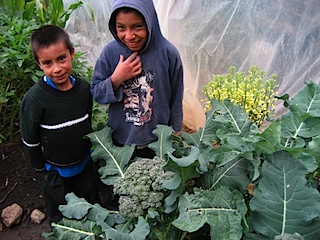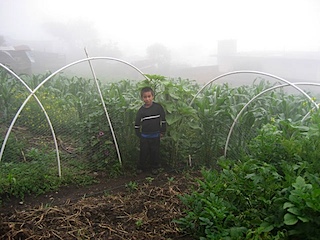
We are back from our long trip, and just in time. A few minutes ago we got a text message from the security chief that Peace Corps Guatemala is on “standfast”, and we aren’t allowed to travel anywhere for the next 48 hours. Some sort of tropical storm is on its way, and might bring landslides, washed out roads, and so forth… as happens in the third world. I’m actually kindof excited about it; I am tired of traveling anyways and it will be nice to be stuck in site for a while. I feel bad for some of our friends, though, who didn’t get out of Huehue in time after yesterday’s meeting and are now trapped away from home.
This is the first time in our entire service that we’ve seen the emergency action plan activated. Being a federal agency, the Peace Corps is all about disaster preparedness. The first level, standfast, means that we can’t travel. The idea is to keep us where they can find us, in the even of some sort of natural disaster or civil unrest. Experience has proven that being in your site is usually the safest place to be, where you have friends and neighbors: locals that know you and can help watch out for you. If things get worse, then phase two is consolidation, where we all move to a predetermined (and secret!) central location. Apparently it happened twice in the year before we arrived in Guatemala. Uncle Sam picks up the tab for our time in the hotel with all the other volunteers, as we wait for the emergency to pass or degrade further to the final phase. That’s evacuation, and it’s a pretty big deal. We like to joke that this is when the Marines show up with Blackhawk helicopters and rescue all the volunteers. What it really means is that we as a group use any means at our disposal to escape the problem; usually a bus to the border or the airport. Evacuation hardly ever happens, but Peace Corps Bolivia had to evacuate in 2008.
Strangely, this has nothing at all to do with Volcano Pacaya erupting yesterday, as we originally thought when we got the message. I am sad to say that we JUST MISSED being in Antigua to see the rain of ash and sand all over the city. We’ve climbed that volcano twice, and got to see molten lava pooping out the side. Sadly, a journalist was killed when he was hit by rocks shooting out the top of the volcano, but for the most part it has been more of an inconvenience than a serious danger. The airport is closed right now, so some of our friends who are finishing early might be trapped in Guatemala until the ash cloud subsides.
We returned to our village to meet the happy faces we’ve come to know so well in our time here. Our friend Antonio invited us into his house for lunch as we were waiting to switch buses in Santa Eulalia, and we had a dozen conversations with various locals within the first few hours back in site. It reminds me that we really HAVE made friends, and I’m going to miss many of them. As is their habit, the neighbor kids started jumping up and down and chanting our names from the mountainside as soon as we stepped off the microbus, then came tearing down the valley to help us carry our various bags and packages up to the house. It’s a ritual now: let’s see what neat stuff the gringoes brought back from their trip. Occasionally we have a sweet or little toy for them, but more than anything they just want to see all of our strange travel items: collapsable toothbrushes, goretex hats, sleeping bags, deodorant.
This particular time, we had a care package from my parents that we’d picked up at the post office in Santa Eulalia. The kids can sniff these out like bloodhounds, and know by now that they often contain a kids’ book in Spanish. My mom started sending them after her visit, and the kids now love to read new books. It’s our private little battle against illiteracy, and I feel like we’re winning it on a small but important scale. Emily had the kids in a circle and was reading to them before I’d even opened the potato chips my Dad sent.
As usual, Chalio and Alberto did a great job watching the garden while we were away. Since the rains are in full swing, it’s like Jack and the Beanstalk. To everyone’s glee, the sunflowers are now taller than Alberto (they still don’t believe me when I say they will get taller than I am). The potatoes are ready to harvest, and we have about five melons. The guicoy (Guatemalan zucchini) I planted has put on fruit, and will be ready soon. I am especially pleased about that one, since Nas’s wife gave me the seeds to plant because she loves guicoy and can’t get it to grow. Heh. The cucumber harvest is now over, but Chalio says they ate a ton of them, and the new ones are already past their seedling leafs. A tomato is FINALLY growing, and my chili plant has mature fruit now as well. The broccoli has heads bigger than my own, though one went all the way to seed while we were gone. Except for a few sweet corns that were munched by the stupid cow, all is well… though the entire garden could stand a good weeding.
So, we’re back and we’re safe, ready to launch in to the final lap.
UPDATE, this just came in:
000
ABPZ20 KNHC 281739
TWOEP
TROPICAL WEATHER OUTLOOK
NWS TPC/NATIONAL HURRICANE CENTER MIAMI FL
1100 AM PDT FRI MAY 28 2010
FOR THE EASTERN NORTH PACIFIC...EAST OF 140 DEGREES WEST LONGITUDE..
SATELLITE IMAGES INDICATE THAT THE BROAD AREA OF LOW PRESSURE
LOCATED A COUPLE HUNDRED MILES SOUTH OF THE GULF OF TEHUANTEPEC IS
GRADUALLY BECOMING BETTER ORGANIZED. ONSHORE WINDS TO THE EAST OF
THE DISTURBANCE CONTINUE TO PRODUCE LOCALLY HEAVY RAINS FROM EL
SALVADOR WESTWARD ALONG THE PACIFIC COAST TO NEAR THE GULF OF
TEHUANTEPEC. THESE RAINS COULD CAUSE LIFE-THREATENING FLASH FLOODS
AND MUD SLIDES IN THESE AREAS OVER THE NEXT COUPLE OF DAYS.
ENVIRONMENTAL CONDITIONS ARE FAVORABLE FOR FURTHER DEVELOPMENT...
AND A TROPICAL DEPRESSION COULD FORM LATER TODAY OR SATURDAY AS IT
DRIFTS NORTHEASTWARD. THERE IS A HIGH CHANCE...70 PERCENT...OF THIS
SYSTEM BECOMING A TROPICAL CYCLONE DURING THE NEXT 48 HOURS.
ELSEWHERE...TROPICAL CYCLONE FORMATION IS NOT EXPECTED DURING THE
NEXT 48 HOURS.
$$
FORECASTER BROWN/STEWART

